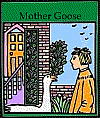


|
 On Reading Nursery Rhymes With Children |
In "Sing a song of sixpence," when the blackbird snip's off the maid's nose, have one hand flap and wobble like a flying bird, then swoop down and touch the child's nose. This both entertains the child, and helps them to learn the names of the parts of the body.
This is assuming that you are reading to the child from one of the many nursery rhyme picture books available. Pointing to a cow in the picture when a cow is mentioned in the rhyme helps to associate the picture and the sound of the word, also expanding the child's vocabulary.
Just think of "Teddy bear, Teddy bear." Every line has something to do. Stand up and act it out with the child. Touch the ground (or if you are seated with child in lap, well, you can still *reach* for the ground, can't you?); turn yourself around or turn something around with your hand; pick up your foot and wave it around for showing the shoe, or grab the child's foot and tickle it; for that will do, shake your finger in a pseudo-scolding motion; and so forth. If these motions seem contrived or awkward for you, come up with your own. The point is to amuse and delight your own child, and you will know best what works for the two of you.Using movement or hand patterns, as in Eensy Weensy Spider, also give the child a chance to imitate you, work physically with you, and practice their motor skills. Start this with children from the very beginning -- there are some researchers who believe that movement languages like American Sign Language are learned by children who are too young to talk. You may find your child imitating your gestures very early on, especially if you make a ritual out of using the same gestures with the same words for certain rhymes.
All children take great delight in the rhythms and melodies of tunes. Remember, your singing voice doesn't matter -- even a jolly rhythmic chant will do, if you are hoarse. The emphasis on the melody and rhythm also helps the child learn the rhyme, increasing their vocabulary, and verbal skills. Even very young children will also imitate the songs, and have favorites they ask for. I have heard children as young as a year and a half trying to sing their favorite nursery rhymes.Back to the Top
Children this age often know many of the rhymes by heart, and are comforted by the familiarity, but aren't aware of some the additional levels of information in the rhymes. It is good to particularly focus on counting rhymes and alphabet rhymes, and use them as an avenue to begin the learning process for these basic skills.Back to the TopOther ways to use rhymes to enhance learning is with the Q&A method. Naturally, if the child asks you questions about why, what, who, how or why (children this age are often still not too aware of "when"), the parent can use these questions as a leaping-off point for enhanced discussions. If the child doesn't seem to ask questions themselves, you can encourage exploration and start the process of teaching critical thinking and reading by starting to ask questions of the child. Good questions to start with are:
This is a good age to start working with riddles and puzzle questions. Often the younger child simply picks up on the sound of the rhyme, and won't fully appreciate some of the wonderful riddles. Older children can also delight in these, so long as they are new to them and their friends.
- "What do you think is happening here?"
- "Why do you think that happened?"
- "Why did they do that?"
- "Would you like to know more about [blank]?"
(something that is happening in the rhyme -- baking bread or feeding hens ... )
"Hey, I'm too old for nursery rhymes!" Well, maybe. There is a wealth of historical trivia attached with the origins of these rhymes. A well known example is "Hey diddle diddle." The line about the dish running away with the spoon is thought to actually refer to the relationship between Queen Elizabeth I and a particular Spanish royal with whom she was spending a great deal of time. The rhyme supposedly expresses concern on the part of Elizabeth's subjects as to what would become of them if she married and moved to Spain. Which never happened, of course, but the story connected with the rhyme brings that whole era of history more to life. Books on this topic can be found in the Recommended Books section of this site. Certain tidbits will be added to enrich the information on these pages as time and space allow.

|
Performance Tips || History || Sources
(c)1995-2005, P. F. Anderson, All graphics, interface, organization, and selected content.
URL of current page: http://www-personal.umich.edu/~pfa/dreamhouse/nursery/reading.html |